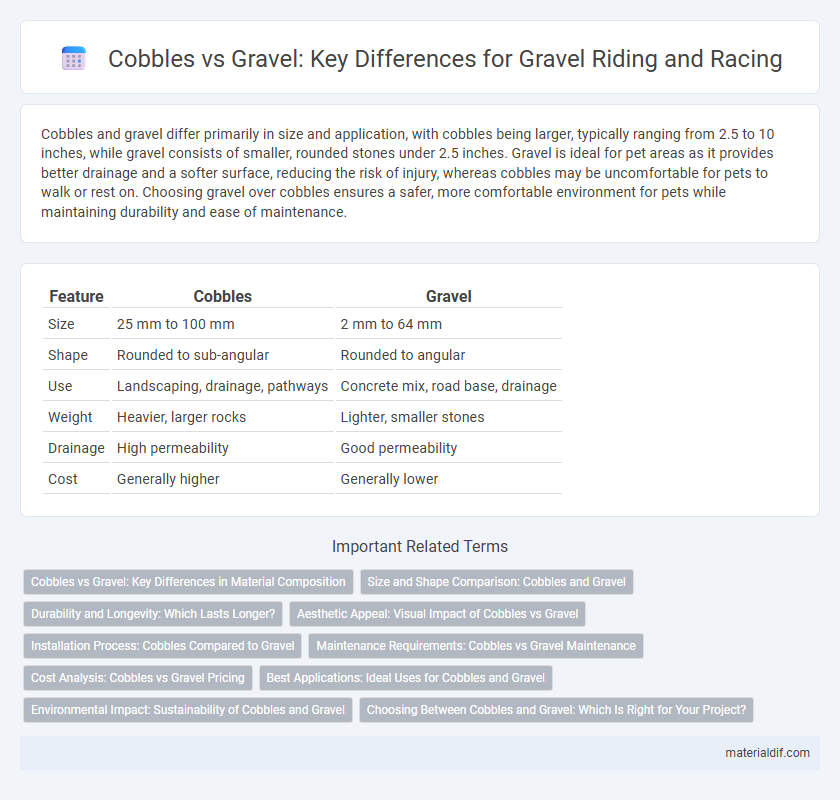Cobbles and gravel differ primarily in size and application, with cobbles being larger, typically ranging from 2.5 to 10 inches, while gravel consists of smaller, rounded stones under 2.5 inches. Gravel is ideal for pet areas as it provides better drainage and a softer surface, reducing the risk of injury, whereas cobbles may be uncomfortable for pets to walk or rest on. Choosing gravel over cobbles ensures a safer, more comfortable environment for pets while maintaining durability and ease of maintenance.
Table of Comparison
| Feature | Cobbles | Gravel |
|---|---|---|
| Size | 25 mm to 100 mm | 2 mm to 64 mm |
| Shape | Rounded to sub-angular | Rounded to angular |
| Use | Landscaping, drainage, pathways | Concrete mix, road base, drainage |
| Weight | Heavier, larger rocks | Lighter, smaller stones |
| Drainage | High permeability | Good permeability |
| Cost | Generally higher | Generally lower |
Cobbles vs Gravel: Key Differences in Material Composition
Cobbles consist of larger rock fragments ranging from 64 to 256 millimeters in diameter, primarily formed from durable igneous or metamorphic materials, while gravel is smaller, typically between 2 and 64 millimeters, composed of a mixture of rock types including sedimentary and volcanic origins. The size and composition differences influence their application in construction, with cobbles frequently used for decorative landscaping and heavy-duty paving, whereas gravel suits drainage layers and concrete aggregates. Material density and shape variations also affect stability and permeability, making cobbles more resistant to displacement compared to the looser, rounder gravel particles.
Size and Shape Comparison: Cobbles and Gravel
Cobbles range in size from 64 to 256 millimeters in diameter, significantly larger than gravel particles, which measure between 2 and 64 millimeters. Cobbles typically have a rounded or sub-angular shape due to natural weathering and erosion processes, whereas gravel can be more angular or rounded depending on its source. The larger size and distinct shape of cobbles make them ideal for applications requiring greater stability and drainage compared to finer gravel materials.
Durability and Longevity: Which Lasts Longer?
Cobbles exhibit superior durability and longevity compared to gravel due to their larger size and natural resistance to weathering and erosion, making them ideal for high-traffic areas and long-term landscaping projects. Gravel, composed of smaller, more fragmented stones, tends to wear down faster under constant pressure and exposure to the elements, requiring more frequent replenishment. Choosing cobbles over gravel increases the lifespan of pathways and driveways while reducing maintenance costs over time.
Aesthetic Appeal: Visual Impact of Cobbles vs Gravel
Cobbles create a distinctive, polished aesthetic with their larger, rounded stones and smooth texture, offering a natural yet refined visual impact that enhances landscape designs. Gravel, composed of smaller, irregular particles, provides a more subtle, uniform appearance that can complement a variety of settings but lacks the bold statement of cobbles. The choice between cobbles and gravel significantly influences the visual character of pathways, driveways, and garden beds, with cobbles often preferred for their striking, sculptural look.
Installation Process: Cobbles Compared to Gravel
Cobbles require a more labor-intensive installation process compared to gravel due to their larger size and irregular shapes, which demand precise placement and leveling. Gravel installation is quicker and simpler, involving spreading and compacting smaller, loose stones that naturally interlock. The stability of cobbles often necessitates a sand or mortar base, while gravel typically rests on a compacted sub-base for drainage and support.
Maintenance Requirements: Cobbles vs Gravel Maintenance
Cobbles require minimal maintenance due to their durability and resistance to erosion, making them ideal for high-traffic areas with less frequent upkeep. Gravel demands regular raking and replenishing to maintain an even surface and prevent weed growth, especially after heavy rainfall or vehicle use. Choosing cobbles reduces long-term maintenance costs, while gravel offers easier installation but requires more consistent care.
Cost Analysis: Cobbles vs Gravel Pricing
Cobbles generally cost more than gravel due to their larger size, durability, and aesthetic appeal, with prices ranging from $50 to $150 per ton compared to gravel's $10 to $50 per ton. Installation costs for cobbles can also be higher because of the need for specialized labor and equipment. Gravel's affordability and ease of installation make it a cost-effective choice for large-scale projects and basic landscaping needs.
Best Applications: Ideal Uses for Cobbles and Gravel
Cobbles, typically 2.5 to 10 inches in diameter, are best suited for landscaping features like decorative borders, drainage systems, and erosion control due to their larger size and stability. Gravel, ranging from 0.1 to 2.5 inches, excels in applications such as driveways, pathways, and concrete aggregate because of its versatility and ease of compaction. Choosing between cobbles and gravel depends on the desired function, load-bearing requirements, and aesthetic goals of the project.
Environmental Impact: Sustainability of Cobbles and Gravel
Cobbles have a lower environmental impact due to their natural sourcing and minimal processing, which reduces carbon emissions compared to gravel, often produced through energy-intensive crushing. Gravel contributes to habitat disruption and increased runoff, whereas cobbles promote better water infiltration and soil stabilization. Sustainable use of cobbles supports erosion control and enhances groundwater recharge, making them a more eco-friendly option in landscaping and construction.
Choosing Between Cobbles and Gravel: Which Is Right for Your Project?
Choosing between cobbles and gravel depends on your project's purpose and aesthetic preferences. Cobbles, larger and more durable, are ideal for landscaping features requiring substantial stability and a natural, rustic appearance, while gravel offers versatility with smaller particle size, better drainage, and easier installation for driveways, paths, and decorative surfaces. Consider factors like load-bearing capacity, maintenance, and visual impact to determine whether cobbles or gravel best suit your design and functional needs.
Cobbles vs gravel Infographic

 materialdif.com
materialdif.com